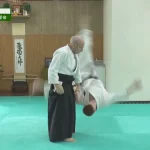Sports Yabusame: Blending traditional equine culture with sport.
Text by Jessica Gerrity
Konnichiwa and hello everyone, I’m Jess and I’ve lived in Japan for 18 years. I love Japan, it’s amazing culture and wonderful traditions. I especially love all things related to the 「yumi」 or Japanese bow. This is my first article for BUDO JAPAN, thank you for visiting the site!
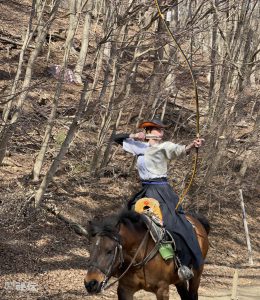
Sports yabusame practice.
My first love is kyudo 「the martial art of Japanese archery」 however one year ago I started a type of horseback archery called sports yabusame. Today I will write about my experience learning this unique activity.
The concept of sports yabusame was made official in 2002 after the establishment of the Federation for Competitive Yabusame (official name:Japan Yabusame Federation).
Competitive or sports yabusame is defined as 「An archer on horseback shooting arrows and accurately hitting 3 targets.」
「*Japan Yabusame Federation」
Being a relatively new type of activity its members are growing year upon year. Sports yabusame is a hybrid of a old traditional martial art 「kobudo」 called yabusame, and a sport: archery.
There are competitions where we hit targets and points are collected similar to other international horseback archery styles.
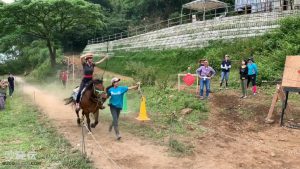
The first time to try sports yabusame.
The traditional martial art riding technique we use is called tachi sukashi where we don’t sit down in the saddle and instead sit just above it and use our legs as suspension as the horse runs. Tachi sukashi requires practice but once you get the hang of it, you can remain relatively stable even when the horse gallops. Our riding equipment such as the saddle and stirrups we use are traditional Japanese style. In a lot of cases they are also antiques as the craftspeople who make these items aren’t alive anymore.
So what are the differences between traditional yabusame and sports yabusame?
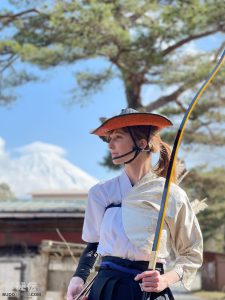
Archers wear a hakama, dougi and an archers sleeve (igote).
There are several differences between traditional yabusame and sports yabusame.
Traditional Yabusame as the name suggests contains deep traditions from more than 800 years ago that have been passed down from generation to generation.
Training to be a traditional yabusame archer or ite involves a shugyo or training period when the apprentice learns everything from the names of all pieces of equipment to the correct method of saddling the horse. The training period for apprentices in traditional yabusame vary between each school of archery. In some cases, a period of years may pass before the apprentice may even start to ride.
A large part of traditional yabusame is related to sacred rituals, and as such shooting methodologies and procedures at these events reflect this with ceremonies being held at Shino shrines at set times of the year.
Finally, traditional yabusame tends to use horse breeds other than indigenous Japanese horses as speed and size of the horse takes priority.
Sports yabusame on the other hand does not have sacred ritual traditions and as such there are also no religious implications.
The training period before becoming an archer is also substantially shorter and depending on your skill level you may be allowed to shoot from horseback (at a walking speed) on your first try!
The schedule is flexible. Most of the horse ranches that offer sports yabusame training will let you train as your schedule allows, even if you only want to try once, that’s ok too.
Taking photos and videos as you practice is allowed and encouraged.
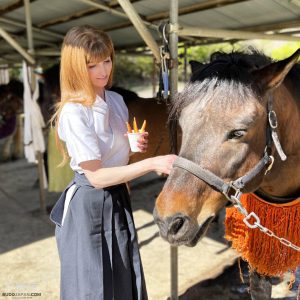
Japanese horses are smaller than other breeds, but very suited to sports yabusame.
Rules and regulations regarding harnesses and archers clothing are more relaxed. You don’t have to purchase expensive equipment or clothing unless you want to, many horse ranches offer rental of helmets, bows and arrows too.
Lastly, indigenous Japanese horses are a top priority for sports yabusame and the Federation for Competitive Yabusame. Close to being endangered, Japanese horses come in approximately 8 breeds.
Sports yabusame aims to combine these wonderful Japanese horses with traditional equipment and techniques to make a type of horseback archery that is still very Japanese but that is flexible and welcoming to everyone regardless of their lifestyle.
So how is sports yabusame different from other types of horseback archery found in other countries?
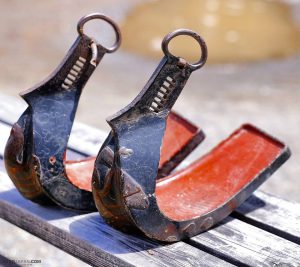
Abumi are Japanese style stirrups. Their shape is very unique.
Sports yabusame uses traditional Japanese style equestrian equipment such as the wa kura/ saddle and wa abumi/the stirrups. The archer uses a Japanese asymmetric longbow/ yumi and shoots either sharp tipped arrows/ soya or bulb tipped arrows/jindouya.
During grading and competition they use an archers sleeve on their left arm/ igote, and predominantly ride on Japanese indigenous horses. Archers wear kimono and hakama, or more traditional garments like suikan or hitatare. Traditional Japanese equestrian riding techniques such as tachi sukashi (mentioned above) help the archer maintain balance when the horse is galloping.
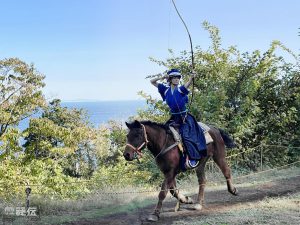
The archer uses a Japanese asymmetric longbow/ yumi.
My experience with sports yabusame has been extremely positive. On the first day I visited to train, I was together with several other beginners which made learning very fun.
We spent the day learning how to get the correct posture, how to shoot the yumi, the correct usage of the equipment, shooting towards targets, and nocking the arrow without looking.
In the afternoon we were allowed to try what we had learnt on horseback! The instructors guided me the whole way at the pace I was comfortable with and walked the horse, and ran with the horse as I took my first shots! It was such an amazing feeling!
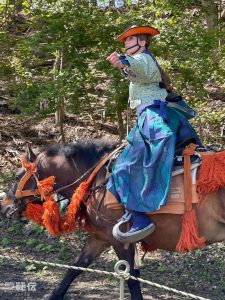
Archers wear kimono and hakama, or more traditional garments like suikan or hitatare.
On the first day I was able to rent all the equipment I needed right there at the horse ranch which was really convenient.
I continued to attend training about once a month as this was as much as my schedule would allow. The instructors worked with my level each time and gave individual feedback on my technique which really helped me improve. The idea of learning at your own pace with a flexible approach on the part of the horse ranch was one of the points that was important to me as I have 3 children and I work too.
One year on, I can ride without an instructor by my side and I can hit targets successfully while cantering. I passed my grading for kokoroe 2kyu which is like shodan or the base level test.
I like that by learning and training in sports yabusame I am not just learning traditional Japanese riding techniques, but that I am riding Japanese horses too. The horse ranch where I practice only keeps Japanese indigenous horses. They aim to help further the population with breeding and educational programs and activities that raise awareness of these wonderful animals.
I really like the support of tradition and indigenous culture that sports yabusame provides.
I think sports yabusame is a wonderful mix of the traditional and modern, whilst still being a very unique Japanese form of horseback archery. If you have a chance to visit Japan please try your hand at sports yabusame!
If you are in Japan and would like to try sports yabusame there are several places around Japan where you can learn.
◯Saddle Back in Odawara, Kanagawa Prefecture:
◯Koyodai Kisouma Horse Ranch in Yamanashi Prefecture:
http://kouyoudaikisouma.g3.xrea.com/index.html
(Some knowledge of Japanese in necessary)
◯Yamato Horse Park in Ibarak Prefecture:
◯Towada Horse Riding Club in Aomori Prefecture:
◯Mikarinonomori Bokujo Riding Club in Shiga Prefecture:
http://kansai.me/mikarinobokujo/
Perhaps you would like to watch sports yabusame instead?
◯Odawarajo Bajo Yumi Kurabe Taikai
Held in March, this is a competition and grading event that is open for the public to watch. Held in a wide open space at the foot of Odawara Castle, you feel like you have slipped back in time.
◯Sakura Yabusame Matsuri
Towada City in Aomori has a Yabusame Cherry Blossom Festival or Sakura Matsuri every April, right when Cherry Blossoms are at their best! This female only archer event is not to be missed!
http://towada-joba.com/sakurayabusame/
【Sources】
・流鏑馬競技連盟 http://www.yabusame-fed.jp/index.html
・『サムライの筋肉が疼く スポーツ流鏑馬入門』市村弘(https://twitter.com/kerpanen)
Text by Jessica Gerrity
Jessica Gerrity was born in New Zealand and has lived in Japan for 18 years. She has 3rd dan in Kyudo, shodan in sports yabusame and practices shihanmato kyudo regularly. She loves everything related to the Japanese bow : yumi.
Instagram: https://instagram.com/jessintokyo







